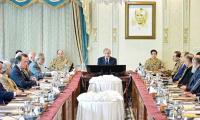With no party managing to claim a simple majority, the next government seems up in the air at the moment. Regardless of outraged commentary, the fact is that it will be a coalition government. It will be formed by making alliances and that will involve some compromises. So what will it be: a PTI-led coalition government or another PDM government? With PTI-backed independent candidates taking the most number of seats, the simple answer would have been for the party to form a coalition government with other political parties. But are things ever simple in Pakistan politics? Especially given the PTI’s particular brand of wanting to do its own thing. So far, Barrister Gohar has categorically stated that the PTI would rather sit in the opposition than make a government with the PPP or the PML-N. If we take that as the given, then the party will not get the numbers to form a government in the centre. Of course, a PTI in the opposition will hardly bode well for any government that is formed. It is also as yet unclear if the PTI will be able to get its reserved seats given that its candidates didn’t contest elections under the PTI banner and symbol.
Meanwhile, the two ‘older’ parties – the PPP and PML-N – are doing what they know best: politics. There have been reports of both public and not-so-public meetings between the two. Reports tell that there is a great chance of a PDM 2.0 but there are different ideas on what modalities will be finalized at the end of negotiations between the two parties. The first option is that of PDM 2.0 ala the first PDM government, which means that both parties will form the government together and be part of the cabinet. Some analysts believe that there will be some give-and-take on positions like the president of Pakistan, chief minister of Balochistan, chairman of Senate, among others. The second option is the Balochistan model where the PML-N will first form the government for three years and the PPP for the next two years with their own prime ministers for these designated terms. For context, a nationalist government was formed in 2013 under Dr Malik and after half of its term, the other half was handed over to the PML-N’s Sanaullah Zehri. In this scenario, there will be two different cabinets altogether. However, some have pointed out that the Balochistan model may not work in the centre as whoever takes the first prime ministership will have to make tough decisions, including going into another IMF programme. When tough economic decisions are taken, the fruits of those decisions will come a few years later. So if the PML-N is able to form the first government and make difficult economic decisions, then it will be blamed for inflation while the PPP will enjoy the benefit of these reforms.
It would be natural for the PPP and PML-N to be nervous about what lies ahead. What if the reforms are not able to steer the country out of the economic mess it is in right now and the PPP has to face inflation as well as the incumbency factor when it goes into elections if it takes the government in the second term? These are questions that the PPP will rightly be pondering. The PML-N, meanwhile, has to worry about its own future which has never looked this shaky before. One thing political experts agree on is that someone has to form a government. We cannot possibly have this situation linger longer than it should. If it is a PDM government – whatever the power-sharing formula they decide to go forward with – or a PTI-led government, then let it happen. Elections should end political uncertainty, not lead to more of the same. A government has to be formed. If the PTI can do it, they should go ahead with it and if they can’t, then the PDM will do what it has to do. Enough uncertainty. The business of state has to restart.
Urgency with which this threat should be handled is unfortunately missing not only in Pakistan but also globally
FBR data shows it collected Rs5.62t in first half of FY2025, falling short of its Rs6.01t target by Rs386 billion
None is older than polio problem, with Pakistan and Afghanistan still only two countries in world yet to put virus...
Over past few years, Pakistan has faced some of most difficult economic times in its history, teetering on brink of...
On security front, terrorism exacts heavy toll, with 1,566 incidents claiming 924 lives
As such, Pakistan is now nearing generalised HIV epidemic according to UNAIDS country director for Pakistan







